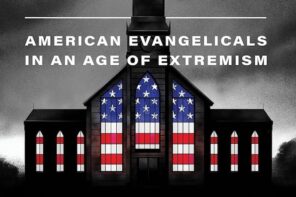In recent months, the Southern Baptist Convention has faced a steady stream of high-profile defections, including black pastors such as Charlie Dates, popular Bible teacher Beth Moore, and Ethics and Religious Liberty Commission President Russell Moore. The recent leak of Russell Moore’s private letter detailing racism and abuse of power at the highest levels of the convention put a sensational exclamation point on the trend. For the nation’s largest body of evangelicals, all the warning lights are flashing red.
Where did white evangelicalism go wrong? To hear many scholars and pundits tell it, the problem is the Christian Right.
Since today’s crisis is most clearly seen in the politics of white evangelicals, stories of what went wrong are most often political stories. They go something like this: white evangelicals didn’t like the changes of the 1960s, so they became Republicans. Cunning political activists like Paul Weyrich seized on the Bob Jones tax exemption case to mobilize voters around the issue of racial segregation. A familiar cast of characters including Jerry Falwell, Ralph Reed, and Pat Robertson are brought on stage to perfect the art of galvanizing white evangelicals with a blend of racial resentment, anti-abortion sentiment, and reaction to the sexual revolution. In this story, even Billy Graham is not innocent. The degradation of evangelical religion then reaches its apex in white evangelicals’ slavish support for Donald Trump.
If you’re interested in white evangelicals, you’ve heard these stories. They’re the white evangelical equivalent of the civil rights mythology that imagines Dr. Martin Luther King Jr. as the singular Great Leader and Rosa Parks as a tired seamstress. They’re simple, surface-level stories that avoid engaging with what white evangelical institutions and communities are like on the inside. Scholars who tell top-down, elite-driven stories of the Civil Rights Movement are unlikely to be taken seriously. But precisely these kinds of stories continue to drive the discussion around white evangelical politics.
The popular story of partisan politics debasing white evangelicalism not only fails to study the roots, it absolves the movement of its deepest failures. White evangelicals who are uneasy about the direction of their movement often use the popular story as a shield against self-scrutiny. They can claim that white evangelicalism is basically sound in its theology; the problem is that it’s been captured by politics.
Indeed, we frequently hear white evangelical elites complaining that the influence of political media has swamped the influence of the local church. As Richard Stearns, President Emeritus of World Vision, tweeted last year, “Pastors have the people for one hour each week – cable news has them every day.” Scholars often make this observation as well.
However, while evangelical clergy only get their congregants in the pews one to three times a week, Fox News and talk radio get them every day, all day.
— Paul Matzko (@PMatzko) May 29, 2021
Implicit in statements like these is the assumption that churches and pastors are a good influence on their congregations. The roots are healthy, but outside forces have corrupted the fruit. These assumptions should not stand unchallenged.
Segregation as pragmatism
It’s time for white evangelical leaders to consider the possibility that their own theology and institutions are at the center of the problem. To seriously consider this, white evangelicals need a history lesson and the willingness to finally listen to what Black evangelicals have been saying for decades.
This history spans centuries, but its modern roots are in white evangelicalism’s reaction to the Civil Rights Movement, a response that goes much deeper than partisanship. The Black freedom struggle transformed the nation’s culture, politics, and public spaces. At the same time, self-described Black evangelicals demanded inclusion and reform in white evangelical institutions. Segregation, in churches as in other institutions of American life, became a toxic brand. While white evangelicals were quick to disavow it, they were just as quick to find new justifications for it. Within a decade of Jim Crow’s demise, the hottest trend in white evangelical church startups taught that racial diversity in local churches threatened church growth.
An influential cadre of white evangelical professors and mission theorists centered at Fuller Seminary assured a new generation of pastors that homogeneous congregations allowed worshippers to feel at home with “Our Kind of People” —i.e. white people—and facilitated healthy church growth. Race was a matter of pragmatism rather than justice; merely a tool that could be used to expand the evangelical coalition. They insisted this had nothing to do with the bad old days of segregation. They were merely finding the most effective ways to spread the gospel.
Ignoring critics like Hilliard, the “Church Growth Movement” took the white evangelical world by storm and aided the rise of celebrity pastors such as Rick Warren and Bill Hybels. Warren received his Doctor of Ministry degree at Fuller and cited Church Growth Movement founder Donald McGavran as one of the key influences on his ministry. By the early 1980s, white evangelicals were beginning to get a heady sense of their own power. The simple story tells us this was the age of Falwell’s Moral Majority. The more important story tells of burgeoning member rolls in local churches as pastors learned to invest in whiteness in the name of spreading the gospel.
The Black evangelical activist and community organizer John Perkins took in this scene and saw self-satisfied white congregations denying their complicity with an age of racial injustice. In 1982 he called white evangelicalism “the most segregated, racist institution in America.” While white evangelicals treated their movement’s success as a sign of God’s blessing and their own devotion to the gospel, Perkins declared that a gospel that didn’t confront American racism was “no gospel at all.”
White evangelicals often liked to think that their theology was unimpeachable. In their view, problems arose only when they failed to faithfully bring that theology to bear on the pressing issues of the day. Perkins cut through this self-serving defense. “There’s something wrong at the root,” he said. White evangelicalism was not captured by cunning outside forces. It was rotting from the inside.
Instead of Perkins’ vision of sacrificial love for community, white evangelicals promoted a privatized faith that was supposed to be a route to the good life. Rick Warren famously created a composite character to focus attention on the kind of person he wanted his church to reach. “Saddleback Sam” was a wealthy white man.
Rather than listen to the warnings of Black evangelicals, white evangelicals set themselves up as the authoritative voice of God. Confident in their ownership of the gospel and their theological rectitude, white evangelicals felt emboldened to expand their influence by any means necessary. The fruit wasn’t long in coming. The movement’s relentless quest for church growth favored pragmatic and charismatic leaders rather than righteous ones. The recent scandals of Bill Hybels and other white evangelical leaders are only the latest in a sad decades-long spectacle.
White evangelicals learned well in their homogeneous churches. From their own institutions they carried an ethos of pragmatic movement-building to the public square. They had learned that investing in whiteness was important long before they met Donald Trump. While some white evangelical elites furrow their brows and wonder how a radicalized political movement has captured their parishioners, the real story is the more enduring influence of white evangelical theology and institutions themselves. Something is wrong at the root.
When Southern Baptists gather in Nashville for their annual meeting later this month, this deeper history is unlikely to be on the agenda. Russell Moore’s private anguish revealed that white evangelicals voting for Donald Trump was the least of his worries. He understood the crisis cuts much closer to home. Moore’s departure will not be the last.





